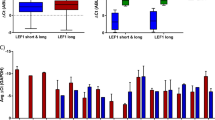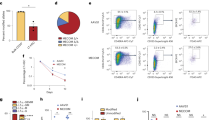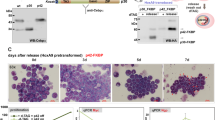Abstract
Identification of genes that regulate clonogenicity of acute myelogenous leukemia (AML) cells is hindered by the difficulty of isolating pure populations of cells with defined proliferative abilities. By analyzing the growth of clonal siblings in low passage cultures of the cell line OCI/AML4 we resolved this heterogeneous population into strata of distinct clonogenic potential, permitting analysis of the transcriptional signature of single cells with defined proliferative abilities. By microarray analysis we showed that the expression of the orphan nuclear receptor EAR-2 (NR2F6) is greater in leukemia cells with extensive proliferative capacity than in those that have lost proliferative ability. EAR-2 is expressed highly in long-term hematopoietic stem cells, relative to short-term hematopoietic stem and progenitor cells, and is downregulated in AML cells after induction of differentiation. Exogenous expression of EAR-2 increased the growth of U937 cells and prevented the proliferative arrest associated with terminal differentiation, and blocked differentiation of U937 and 32Dcl3 cells. Conversely, silencing of EAR-2 by short-hairpin RNA initiated terminal differentiation of these cell lines. These data identify EAR-2 as an important factor in the regulation of clonogenicity and differentiation, and establish that analysis of clonal siblings allows the elucidation of differences in gene expression within the AML hierarchy.
This is a preview of subscription content, access via your institution
Access options
Subscribe to this journal
Receive 12 print issues and online access
$259.00 per year
only $21.58 per issue
Buy this article
- Purchase on Springer Link
- Instant access to full article PDF
Prices may be subject to local taxes which are calculated during checkout







Similar content being viewed by others
Accession codes
References
McCulloch EA . The blast cells of acute myeloblastic leukaemia. Clin Haematol 1984; 13: 503–515.
Mackillop WJ, Ciampi A, Till JE, Buick RN . A stem cell model of human tumor growth: implications for tumor cell clonogenic assays. J Natl Cancer Inst 1983; 70: 9–16.
Ichim CV, Wells RA . First among equals: the cancer cell hierarchy. Leuk Lymphoma 2006; 47: 2017–2027.
Bonnet D, Dick JE . Human acute myeloid leukemia is organized as a hierarchy that originates from a primitive hematopoietic cell. Nat Med 1997; 3: 730–737.
Lapidot T, Sirard C, Vormoor J, Murdoch B, Hoang T, Caceres-Cortes J et al. A cell initiating human acute myeloid leukaemia after transplantation into SCID mice. Nature 1994; 367: 645–648.
Blair A, Hogge DE, Sutherland HJ . Most acute myeloid leukemia progenitor cells with long-term proliferative ability in vitro and in vivo have the phenotype CD34(+)/CD71(−)/HLA-DR. Blood 1998; 92: 4325–4335.
Iscove NN, Barbara M, Gu M, Gibson M, Modi C, Winegarden N . Representation is faithfully preserved in global cDNA amplified exponentially from sub-picogram quantities of mRNA. Nat Biotechnol 2002; 20: 940–943.
Mettler U, Vogler G, Urban J . Timing of identity: spatiotemporal regulation of hunchback in neuroblast lineages of Drosophila by seven-up and prospero. Development 2006; 133: 429–437.
Ahn MY, Huang G, Bae SC, Wee HJ, Kim WY, Ito Y . Negative regulation of granulocytic differentiation in the myeloid precursor cell line 32Dcl3 by ear-2, a mammalian homolog of Drosophila seven-up, and a chimeric leukemogenic gene, AML1/ETO. Proc Natl Acad Sci U S A 1998; 95: 1812–1817.
Koistinen P, Wang C, Yang GS, Wang YF, Williams DE, Lyman SD et al. OCI/AML-4 an acute myeloblastic leukemia cell line: regulation and response to cytosine arabinoside. Leukemia 1991; 5: 704–711.
Fazekas de St G . The evaluation of limiting dilution assays. J Immunol Methods 1982; 49: R11–R23.
Sukhai MA, Wu X, Xuan Y, Zhang T, Reis PP, Dube K et al. Myeloid leukemia with promyelocytic features in transgenic mice expressing hCG-NuMA-RARalpha. Oncogene 2004; 23: 665–678.
Kamel-Reid S, Zhang T, Wells RA . Expression of NPM-RARalpha fusion gene in hematopoietic cells confers sensitivity to troglitazone-induced apoptosis. Oncogene 2003; 22: 6424–6435.
Brady G, Billia F, Knox J, Hoang T, Kirsch IR, Voura EB et al. Analysis of gene expression in a complex differentiation hierarchy by global amplification of cDNA from single cells. Curr Biol 1995; 5: 909–922.
Brady G, Iscove NN . Construction of cDNA libraries from single cells. Methods Enzymol 1993; 225: 611–623.
Nakano T, Kodama H, Honjo T . Generation of lymphohematopoietic cells from embryonic stem cells in culture. Science 1994; 265: 1098–1101.
Billia F, Barbara M, McEwen J, Trevisan M, Iscove NN . Resolution of pluripotential intermediates in murine hematopoietic differentiation by global complementary DNA amplification from single cells: confirmation of assignments by expression profiling of cytokine receptor transcripts. Blood 2001; 97: 2257–2268.
Benveniste P, Frelin C, Janmohamed S, Barbara M, Herrington R, Hyam D et al. Intermediate-term hematopoietic stem cells with extended but time-limited reconstitution potential. Cell Stem Cell 2011; 6: 48–58.
Miyajima N, Kadowaki Y, Fukushige S, Shimizu S, Semba K, Yamanashi Y et al. Identification of two novel members of erbA superfamily by molecular cloning: the gene products of the two are highly related to each other. Nucleic Acids Res 1988; 16: 11057–11074.
Begemann G, Michon AM, vd Voorn L, Wepf R, Mlodzik M . The Drosophila orphan nuclear receptor seven-up requires the Ras pathway for its function in photoreceptor determination. Development 1995; 121: 225–235.
Kerber B, Fellert S, Hoch M . Seven-up, the Drosophila homolog of the COUP-TF orphan receptors, controls cell proliferation in the insect kidney. Genes Dev 1998; 12: 1781–1786.
Kramer S, West SR, Hiromi Y . Cell fate control in the Drosophila retina by the orphan receptor seven-up: its role in the decisions mediated by the ras signaling pathway. Development 1995; 121: 1361–1372.
Mlodzik M, Hiromi Y, Weber U, Goodman CS, Rubin GM . The Drosophila seven-up gene, a member of the steroid receptor gene superfamily, controls photoreceptor cell fates. Cell 1990; 60: 211–224.
Warnecke M, Oster H, Revelli JP, Alvarez-Bolado G, Eichele G . Abnormal development of the locus coeruleus in Ear2(Nr2f6)-deficient mice impairs the functionality of the forebrain clock and affects nociception. Genes Dev 2005; 19: 614–625.
Hermann-Kleiter N, Gruber T, Lutz-Nicoladoni C, Thuille N, Fresser F, Labi V et al. The nuclear orphan receptor NR2F6 suppresses lymphocyte activation and T helper 17-dependent autoimmunity. Immunity 2008; 29: 205–216.
Zhu XG, Park KS, Kaneshige M, Bhat MK, Zhu Q, Mariash CN et al. The orphan nuclear receptor Ear-2 is a negative coregulator for thyroid hormone nuclear receptor function. Mol Cell Biol 2000; 20: 2604–2618.
Ladias JA . Convergence of multiple nuclear receptor signaling pathways onto the long terminal repeat of human immunodeficiency virus-1. J Biol Chem 1994; 269: 5944–5951.
Okuda T, van Deursen J, Hiebert SW, Grosveld G, Downing JR . AML1, the target of multiple chromosomal translocations in human leukemia, is essential for normal fetal liver hematopoiesis. Cell 1996; 84: 321–330.
Christiansen DH, Andersen MK, Pedersen-Bjergaard J . Mutations of AML1 are common in therapy-related myelodysplasia following therapy with alkylating agents and are significantly associated with deletion or loss of chromosome arm 7q and with subsequent leukemic transformation. Blood 2004; 104: 1474–1481.
Harada H, Harada Y, Niimi H, Kyo T, Kimura A, Inaba T . High incidence of somatic mutations in the AML1/RUNX1 gene in myelodysplastic syndrome and low blast percentage myeloid leukemia with myelodysplasia. Blood 2004; 103: 2316–2324.
Acknowledgements
We thank Deborah Hyam and Mary Barbara for excellent technical assistance, Dr Suzanne Kamel-Reid for providing patient specimens, and Zeynep Alkan and Dr Brian Leber for their critical reading of the manuscript. This work was funded by a generous donation from the estate of J Douglas Crashley, a Canadian Institutes of Health Research operating grant (MOP 42420), a HSC Foundation New Investigator Award to RAW, CIHR Clinician Scientist awards to HLA and RAW, operating grants from the CCSRI and Terry Fox Foundation and support from the Princess Margaret Hospital Foundation and the Ontario Ministry of Health and Long Term Care to NNI and a CIHR-Canada Graduate Scholarship, an Adel S Sedra Award of Excellence, a Dr Joe Connolly Memorial OSOTF Award, a Government of Ontario/Dr Dina Gordon Malkin Graduate Scholarship in Science and Technology and a Frank Fletcher Memorial OSOTF Award to CVI.
Author information
Authors and Affiliations
Corresponding author
Ethics declarations
Competing interests
The authors declare no conflict of interest.
Additional information
Supplementary Information accompanies the paper on the Leukemia website
Supplementary information
Rights and permissions
About this article
Cite this article
Ichim, C., Atkins, H., Iscove, N. et al. Identification of a role for the nuclear receptor EAR-2 in the maintenance of clonogenic status within the leukemia cell hierarchy. Leukemia 25, 1687–1696 (2011). https://doi.org/10.1038/leu.2011.137
Received:
Revised:
Accepted:
Published:
Issue Date:
DOI: https://doi.org/10.1038/leu.2011.137
Keywords
This article is cited by
-
Targeting the orphan nuclear receptor NR2F6 in T cells primes tumors for immune checkpoint therapy
Cell Communication and Signaling (2020)
-
MiR-142-3p suppresses the proliferation, migration and invasion through inhibition of NR2F6 in lung adenocarcinoma
Human Cell (2019)
-
The orphan nuclear receptor EAR-2 (NR2F6) inhibits hematopoietic cell differentiation and induces myeloid dysplasia in vivo
Biomarker Research (2018)
-
Orphan nuclear receptor HNF4G promotes bladder cancer growth and invasion through the regulation of the hyaluronan synthase 2 gene
Oncogenesis (2013)



